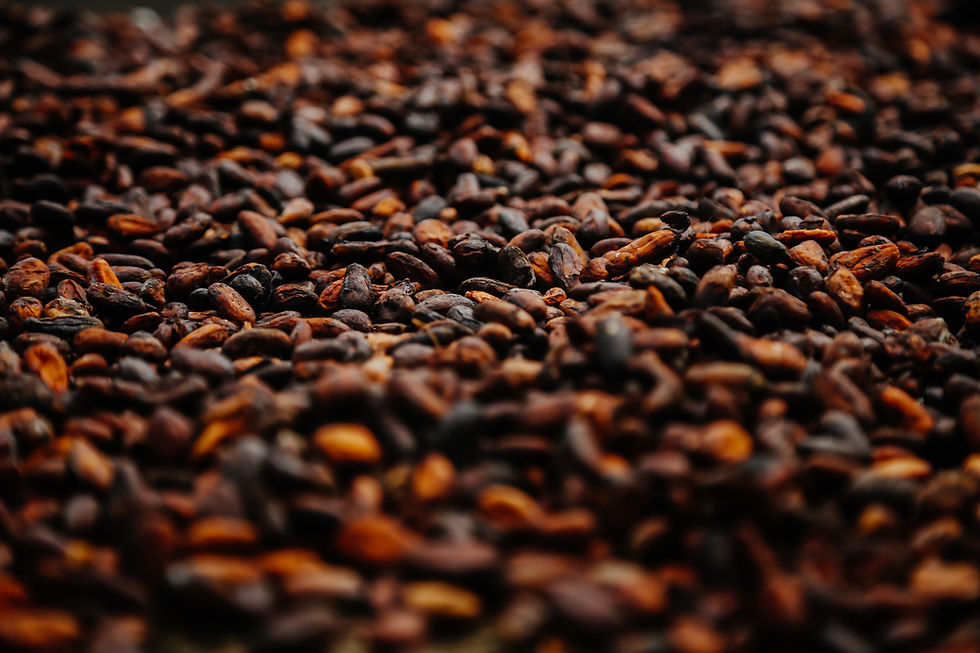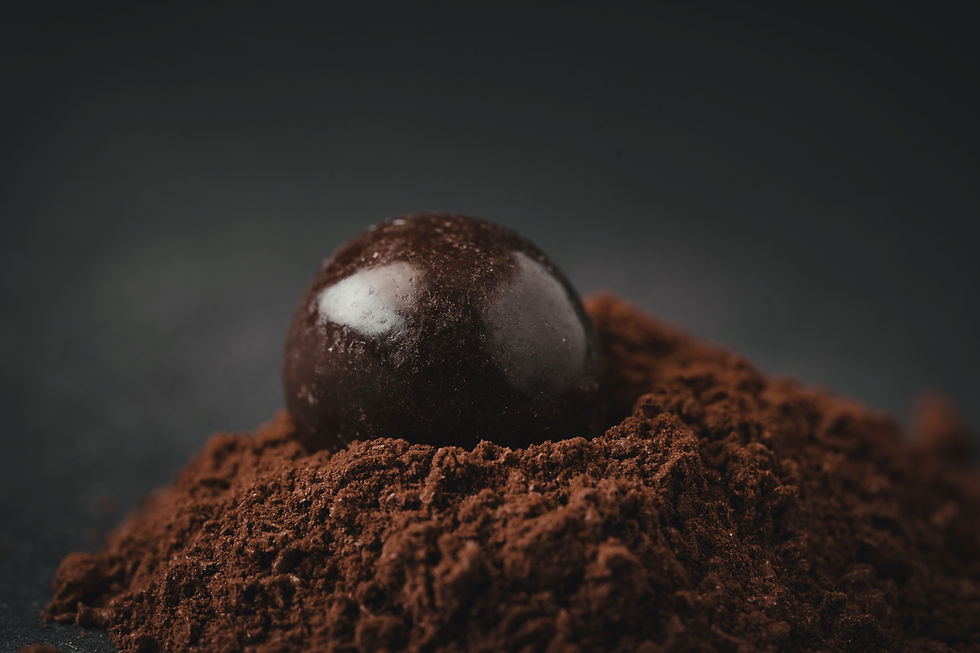Health Benefits of Cacao
- Jul 28, 2023
- 6 min read
Updated: Aug 26, 2024
Cacao is a fruit produced by the Theobroma cacao plant. This tree, which grows primarily in Africa, South America and Central America, produces pods that contain cacao beans. Those beans, which are sometimes called cacao seeds, undergo processing to become chocolate.
Chocolate bars aren’t exactly superfoods, but the cacao they’re made from is full of nutrients. Cacao is rich in antioxidants, as well as critical minerals like magnesium and iron.
Healthy dietary sources of cacao include ingredients like unsweetened cacao powder and cacao nibs. Cacao nibs are small, crunchy pieces of cacao beans that have been dried. Supplements like cacao capsules or liquid extracts are also available.
Not all forms of cacao are created equal. While some popular candy bars are technically made with cacao, they won't necessarily deliver the same nutrients as minimally processed alternatives like unsweetened cacao powder and nibs would.
Here are some of the biggest health benefits of cacao.
May Improve Heart Health
Researchers have identified a potential link between cacao consumption and cardiovascular health. In a study published in 2022, researchers assessed the effects of supplementing with cacao extract on the risk of developing a cardiovascular disease.
While consuming cacao daily did not lower the incidence of heart attacks or strokes, it did correlate with a significantly lower risk of death due to heart disease. That is, study participants who took a daily cacao supplement for 3.5 years were found to have a 27% lower risk of cardiovascular disease-related death when compared to study participants who were given a placebo.1
Other small studies report that the antioxidants in cacao may temporarily improve blood vessel function and increase the body’s production of nitric oxide, a compound that helps lower blood pressure levels.2 Antioxidants are substances that minimize tissue damage in the body and in turn lower your risk of chronic disease over time.
Unfortunately, the most common forms of cacao (like chocolate bars) contain low levels of those antioxidants. That’s because these products undergo lengthy manufacturing processes that degrade cacao’s natural antioxidants.3 Ultra-processed cacao products like chocolate candies also tend to be high in added sugars.
In summary, minimally processed, unsweetened cacao products like cacao powders and cacao nibs contain compounds that may support a healthy heart, but an overly processed bar of chocolate likely won't give you the same benefits.
Rich in Minerals
Just one tablespoon of cacao powder can deliver 10% of your daily magnesium needs. Magnesium is required for hundreds of processes in the body, including reactions that support blood sugar balance, healthy digestion, and relaxation.
The iron naturally found in cacao is needed for maintaining healthy red blood cells and optimal energy levels.
Packed with Antioxidants
Cacao is rich in potent polyphenols. Polyphenols are compounds naturally found in plants, which include antioxidants like flavonoids and catechins.
When it comes to dietary antioxidants, cacao ranks high. A 2012 paper reported that cacao has even stronger antioxidant properties than beverages like green and black teas, as well as red wine.
Research suggests that cacao's antioxidants can improve your blood pressure levels and circulation, lower inflammation, and may even reduce cancer cell activity.
How to Use Cacao
The healthiest way to consume cacao is as unsweetened cacao powder or cacao nibs. Dark chocolate that's at least 72% cacao is another great way to incorporate cacao into your diet. Generally, the higher the chocolate's cacao content, the more antioxidants it will contain.
Cacao powders are made from dried and fermented cacao beans that have had the cacao butter component removed. These powders, along with cacao nibs and antioxidant-rich chocolate, are among the safest and most versatile ways to enjoy the ingredient.
Unsweetened cacao powders can add flavor to a variety of recipes, without all of the added sugars typically found in chocolate candy bars.
Easy ways to incorporate cacao powder or cacao nibs into your diet can include:
Adding them to smoothies
Stirring them into plain Greek yogurt for a high-protein breakfast, snack, or dessert
Incorporating them into homemade baked goods like brownies and muffins
Adding a spoonful of either into oatmeal or overnight oats
Combining cacao powder and milk to make hot chocolate
Dosage
There’s limited evidence that supplementing with cacao is useful or effective for treating health conditions. As a result, there are no official recommendations for the optimal dosage of cacao supplements that come in capsule or extract form.
Serving sizes of cacao powders and cacao nibs typically range from 1 teaspoon to 1 tablespoon, depending on the brand.
Is Cacao Safe?
Cacao is generally well tolerated when consumed in moderate amounts. As with all supplements, cacao supplements are not regulated by the Food and Drug Administration (FDA). This means cacao capsules or extracts may contain additional ingredients, or inaccurate amounts of cacao than what’s listed on the product's label.
Heavy metals like lead and cadmium have also been found in cacao-based products, including chocolate bars.6
Consumer Reports. Lead and cadmium could be in your dark chocolate.
These harmful metals can enter cacao plants by way of the soil they’re grown in.
You can minimize your exposure to these harmful substances by consuming cacao in moderation. It may be a good idea to buy cacao nibs, powders, and chocolate bars from trusted brands that undergo third party testing. Brands that undergo third party testing have outside groups assess their products for quality and purity.
Other promising distinctions include fair trade and organic certifications on cacao product labels.
Can You Have Too Much Cacao?
Cacao naturally contains low amounts of caffeine. One tablespoon of cacao powder may contain about 12 milligrams of caffeine, whereas 1 tablespoon of cacao nibs may contain about 14 milligrams.78 By comparison, a standard 8-ounce cup of coffee typically contains about 100 milligrams of caffeine.9
While cacao isn't too high in caffeine, consuming excessive amounts of it could potentially lead to high caffeine intake and its associated side effects.
It’s particularly important to be mindful of your cacao intake if you know you are sensitive to caffeine or are currently pregnant or breastfeeding. Consuming more than 200 milligrams of caffeine per day while pregnant has been linked to pregnancy complications.10
Potential Interactions
It's rare, but cacao has the potential to interact with certain medications.
Here are a few classes of drugs that cacao may interfere with:11
Blood pressure medications: Cacao may lower blood pressure levels. Consuming cacao along with medications aimed at lowering blood pressure may increase the risk of hypotension, or dangerously low blood pressure levels.
Blood thinners: Since cacao may reduce clotting activity, it could potentially lead to excessive bleeding if it’s consumed in high amounts in combination with drugs that prevent blood clots.
Diuretics: Cacao contains a compound called theobromine that acts as a diuretic, meaning it increases urine production. Cacao consumption along with diuretic medications may increase the risk of dangerously low blood potassium levels, as both substances reduce the amount of electrolytes in the body.
Stimulants: Simultaneous consumption of stimulants like ephedrine and cacao may lead to high blood pressure and heart complications.
What to Look For
When it comes to cacao powders, choose one that's made from 100% unsweetened cacao, not cocoa. Whereas cacao powders are minimally processed, cocoa powders are alkalized. This means they’ve been mixed with a chemical solution to lessen their acidity and bitter taste. Cocoa powders also tend to have other ingredients, like added sugars, as well as lower amounts of antioxidants compared to cacao powders.
On the other hand, products like cacao extract or capsules are not produced by reputable brands that have undergone third party testing. You’re better off consuming dietary cacao in the form of high quality, unsweetened cacao powders, cacao nibs, or dark chocolate.
Side Effects of Cacao
Cacao is generally well tolerated when consumed in moderate amounts. Uncommon, but possible, side effects of cacao consumption are similar to those associated with most plant foods, such as nausea, headaches, and digestive discomfort. Another rare side effect is increased heart rate due to cacao's caffeine content.11
A Quick Review
Cacao is rich in antioxidants and a good source of nutrients like magnesium and iron. However, there’s limited research supporting supplementing with cacao in capsule or extract form.
You can incorporate minimally processed forms of cacao into your diet by adding a spoonful of organic, unsweetened cacao powder or cacao nibs to your meals. A good choice is dark chocolate that contains at least 72% cacao.
Beware that cacao contains low amounts of caffeine and may interact with certain medications. Talk to your healthcare provider before incorporating high amounts of cacao into your diet, especially if you take any of the medications noted above or are currently pregnant or breastfeeding.
Information:
Website: www.opetitmaison.com
Hotline: 0903453365
Address: Petit Coffee, 31 Nam Ho, Ward 11, Da Lat, Lam Dong





Comentarios